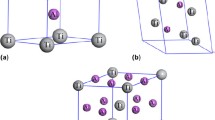Abstract
The formation enthalpy, electronic structures, and elastic moduli of the intermetallic compound Ti5Si3 with substitutions Zr, V, Nb, and Cr are investigated by using first-principles methods based on the density-functional theory. Our calculation shows that the site occupancy behaviors of alloying elements in Ti5Si3, determined by their atom radius, are consistent with the available experimental observations. Furthermore, using the Voigt-Reuss-Hill (VRH) approximation method, we obtained the bulk modulus B, shear modulus G, and the Young’s modulus E. Among these four substitutions, the V, Nb, and Cr substitutions can improve the ductility of Ti5Si3 effectively, while Zr substitution has little effect on the elastic properties of T15S13. The elastic property variations of Ti5Si3 due to different substitutions are found to be correlated with the Me4d-Me4d antibonding and the strengthened Me-Si bonding in the solids.
Similar content being viewed by others
References
Z.H. Tang, J.J. Williams, A.J. Thorn, and M. Akinc: High temperature oxidation behavior of Ti5Si3-based intermetallics. Interme-tallics 16, 1118 (2008).
H.Y. Wang, S.J. Lii, M. Zha, S.T. Li, C. Liu, and Q.C. Jiang: Influence of Cu addition on the self-propagating high-temperature synthesis of Ti5Si3 in Cu-Ti-Si system. Mater. Chem. Phys. 111, 463 (2008).
R. Mitra: Microstructure and mechanical behavior of reaction hot-pressed titanium silicide and titanium silicide-based alloys and composites. Metall. Mater. Trans. A 29, 1629 (1998).
L. Zhang and J. Wu: Ti5Si3 and Ti5Si3-based alloys: Alloying behavior, microstructure and mechanical property evaluation. Acta Mater. 46, 3535 (1998).
R. Rosenkranz, G. Frommeyer, and W. Smarsly: Microstructures and properties of high melting point intermetallic Ti5Si3 and TiSi2 compounds. Mater. Sci. Erie.. A 152, 288 (1992).
P.J. Counihan, A. Crawford, and N.N. Thadhani: Influence of dynamic densification on nanostructure formation in Ti5Si3 intermetallic alloy and its bulk properties. Mater. Sci. Em.. A 267, 26 (1999).
J.J. Williams, Y.Y. Ye, M.J. Kramer, K.M. Ho, L. Hong, C.L. Fu, and S.K. Malik: Theoretical calculations and experimental measurements of the structure of Ti5Si3 with interstitial additions. Intermetallics 8, 937 (2000).
J.H. Schneibel and C.J. Rawn: Thermal expansion anisotropy of ternary titanium silicides based on Ti5Si3. Acta Mater. 52, 3843 (2004).
E.Y. Gutmanas and I. Gorman: Reactive synthesis of ceramic-matrix composites under pressure. Ceram. Int. 26, 699 (2000).
M. Ekman and V. Ozolins: Electronic structure and bonding properties of titanium silicides. Phys. Rev. B 57, 4419 (1998).
T. Kajitani, T. Kawase, K. Yamada, and M. Hirabayashi: Site occupation and local vibration of hydrogen isotopes in hexagonal Ti5Si3H(D)1-x. Trans. Jpn. Inst. Met. 27, 639 (1986).
A.J. Thorn, V.G. Young, and M. Akinc: Lattice trends in Ti5Si3Zx (Z = B, C, N, O and 0 > x > 1). J. Alloys Compel. 296, 59 (2000).
Y. Chen, J.X. Shang, and Y. Zhang: Bonding characteristics and site occupancies of alloying elements in different Nb5Si3 phases from first principles. Phys. Rev. B 76, 184204 (2007).
C.L. Zhang, P. Han, J.M. Li, and M. Chi: First-principles study of the mechanical properties of NiAl microalloyed by M (Y, Zr, Nb, Mo, Tc, Ru, Rh, Pd, Ag, Cd). J Phys. D: Appl. Phys. 41, 095410 (2008).
D. Pettifor: Theoretical predictions of structure and related properties of intermetallics. Mater. Sci. Technol. 8, 345 (1992).
S.F. Pugh: Relations between the elastic moduli and the plastic properties of poly crystalline pure metals. Philos. Mag. 45, 823 (1954).
S.H. Jhi, J. Ihm, S.G. Louie, and M.L. Cohen: Electronic mechanism of hardness enhancement in transition-metal carbonitrides. Nature 399, 132 (1999).
J.Y. Wang and Y.C. Zhou: Dependence of elastic stiffness on electronic band structure of nanolaminate M2AlC (M = Ti, V, Nb, and Cr) ceramics. Phys. Rev. B 69, 214111 (2004).
M.D. Segall, P.J.D. Lindan, M.J. Probert, C.J. Pickard, P.J. Hasnip, S.J. Clark, and M.C. Payne: First-principles simulation: Ideas, illustrations and the CASTEP code. J. Phys. Condens. Matter 14, 2717 (2002).
D. Vanderbilt: Soft self-consistent pseudopotentials in a generalized eigenvalue formalism. Phys. Rev. B 41, 7892 (1990).
J.P. Perdew, J.A. Chevary, S.H. Vosko, K.A. Jackson, M.R. Pederson, D.J. Singh, and C. Fiolhais: Atoms, molecules, solids, and surfaces: Applications of the generalized gradient approximation for exchange and correlation. Phys. Rev. B 46, 6671 (1992).
J.D. Pack and H.J. Monkhorst: “Special points for Brillouin-zone integrations”—A reply. Phys. Rev. B 16, 1748 (1977).
E. Artacho, E. Anglada, O. Dieguez, J.D. Gale, A. Garcia, J. Junquera, R.M. Martin, P. Ordejon, J.M. Pruneda, D. Sanchez-Portal, and J.M. Soler: The SIESTA method: Developments and applicability. J. Phys. Condens. Matter 20, 064208 (2008)
T.H. Fischer and J. Almlof: General methods for geometry and wave function optimization. J. Phys. Chem. 96, 9768 (1992).
W. Voigt: Physical Properties of Crystals, 2nd ed. (Teubner, Leipzig, 1928), 716.
A. Reuss: Calculation of low limit of mixed crystals. Z. Angew. Math. Mech 9, 49 (1929).
R. Hill: The elastic behavior of a crystalline aggregate. Proc. Phys. Soc. London, Sect. A 65, 349 (1952).
K. Kishida, M. Fujiwara, H. Adachi, K. Tanaka, and H. Inui: Plastic deformation of single crystals of Ti5Si3 with the hexagonal D88 structure. Acta Mater. 58, 846 (2010).
C. Filippi, D.J. Singh, and C.J. Umrigar: All-electron local-density and generalized-gradient calculations of the structural properties of semiconductors. Phys. Rev. B 50, 14947 (1994).
L. Zhang and J. Wu: Thermal expansion and elastic moduli of the silicide based intermetallic alloys. Scr. Mater. 38, 307 (1998).
X. Long and Z. Chong: Electronic structure of titanium silicides. Trans. Nonferrous Met. Soc. China 4, 25 (1994).
Author information
Authors and Affiliations
Corresponding author
Rights and permissions
About this article
Cite this article
Wang, HY., Si, WP., Li, SL. et al. First-principles study of the structural and elastic properties of Ti5Si3 with substitutions Zr, V, Nb, and Cr. Journal of Materials Research 25, 2317–2324 (2010). https://doi.org/10.1557/jmr.2010.0293
Received:
Accepted:
Published:
Issue Date:
DOI: https://doi.org/10.1557/jmr.2010.0293



